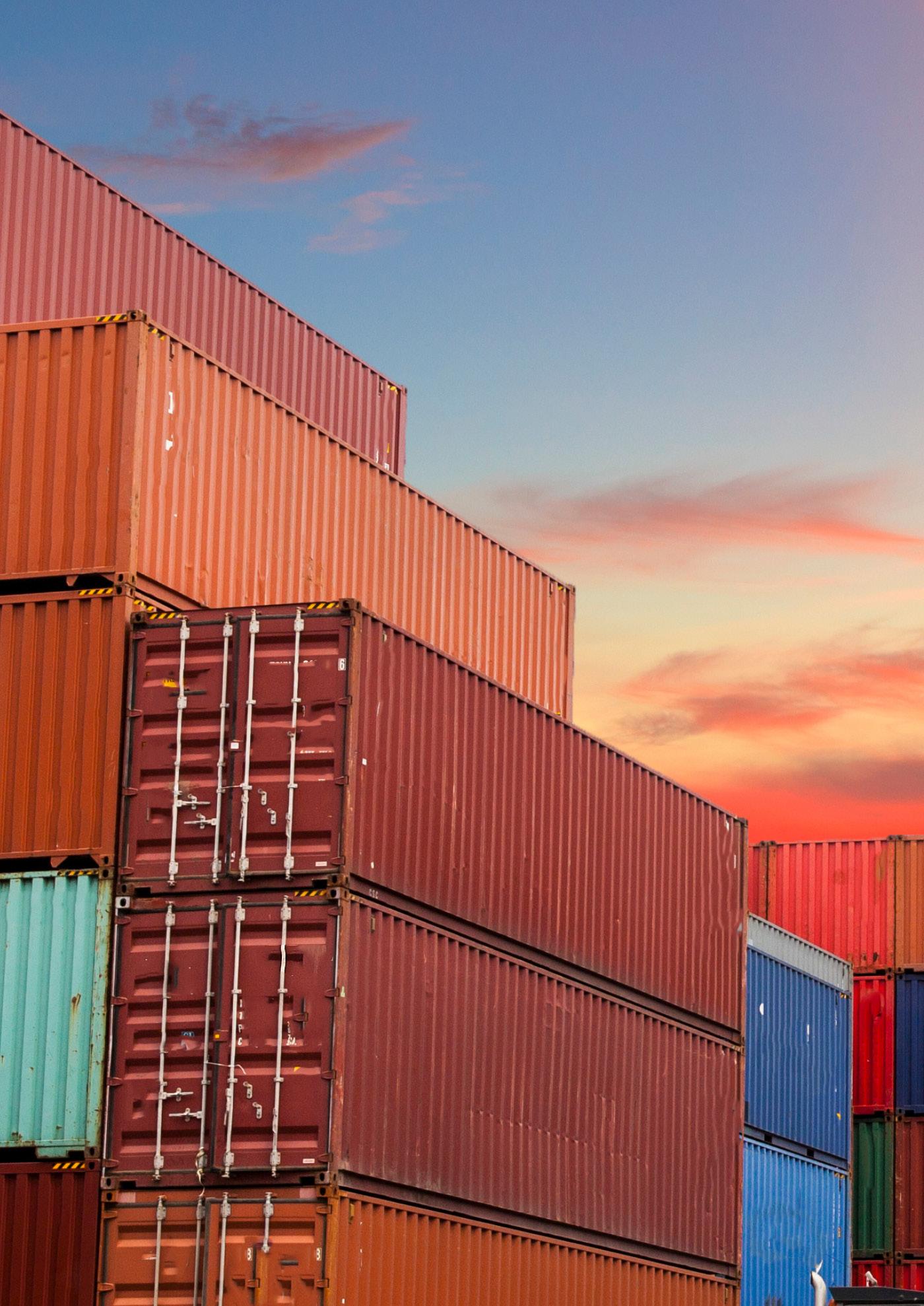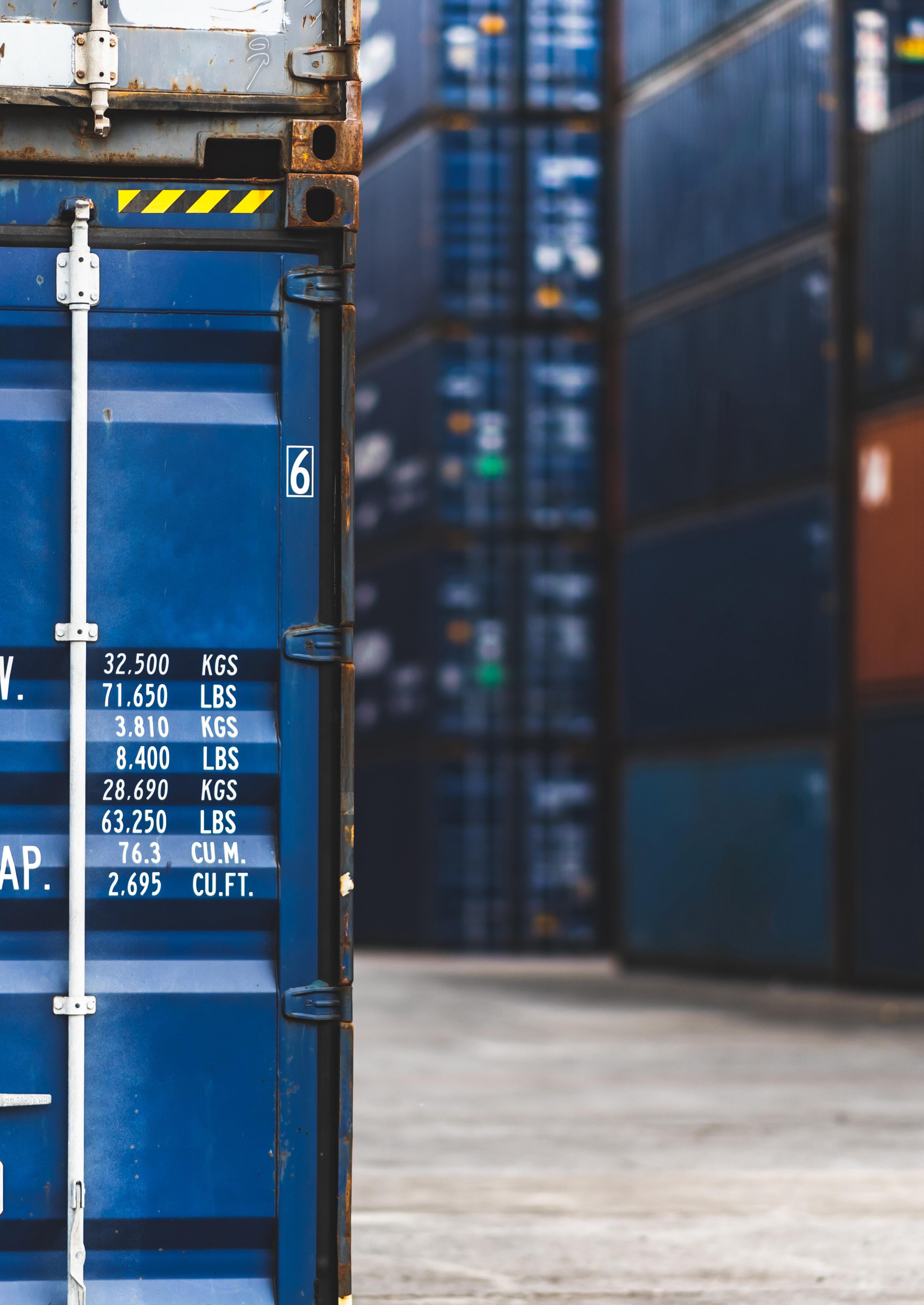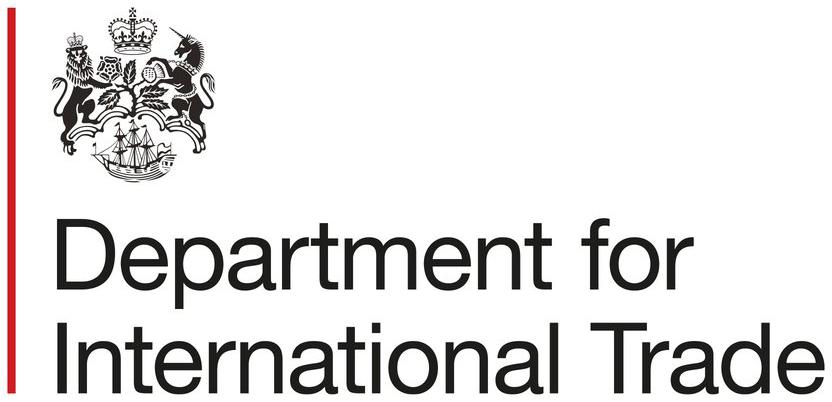TRADE & EXPORT FINANCE GUIDE


2022
UK
This is a jointly produced guide between Department for International Trade (DIT), Trade Finance Global (TFG) and UK Export Finance (UKEF)
DIT, TFG and UKEF would like to extend a special thank you to all contributors.
PHOTOGRAPHS AND ILLUSTRATIONS

FREEPIK COMPANY S.L. ADDRESS
TRADE FINANCE GLOBAL 2ND FLOOR 201 HAVERSTOCK HILL BELSIZE PARK LONDON NW3 4QG TELEPHONE +44 (0) 20 3865 3705
Trade Finance Global is the trading name of TFG Publishing Ltd.
©, Trade Finance Global 2022. No part of this publication may be reproduced in whole or part without permission from the publisher. The views expressed in this guide are those of the respective contributors and are not necessarily shared by the Department for International Trade, Trade Finance Global or UK Export Finance.
Although Trade Finance Global has made every effort to ensure the accuracy of this publication, neither it nor any contributor can accept any legal responsibility whatsoever for the consequences that may arise from any opinions or advice given. This publication is not a substitute for any professional advice.
warehouse finance
(SCF)

Contents 3 1 Foreword 4 2 Explanation of the current climate for trade 6 2.1 COVID-19 8 2.2 Brexit 8 2.3 Russia-Ukraine 9 3 Definition of trade finance and products covered 11 3.1 Why is trade finance necessary? 13 3.2 Who benefits from trade finance? 13 3.3 What are the main benefits of trade finance? 13 4 An Introduction to the trade cycle 14 5 Types of trade finance 18 6 An introduction to UKEF support 22 7 Pre-shipment, post-shipment, and supply chain finance 26 7.1 Pre-shipment finance 28 7.1.1 Trade and receivables finance 28 7.1.2 Inventory or
29 7.1.3 Pre-payment finance 29 7.2 Post-shipment finance 30 7.3 Supply chain finance
30 8 Types of payment: funded versus unfunded trade finance 31 9 Risks and challenges of trade finance 33 10 Trade digitisation 36 11 Providers of trade and export finance 40 12 UK case studies 44 13 Conclusion 48 Glossary 52 CONTENTS
FOREWORD

1
Whether you are trading goods overseas for the first time, or looking to expand your international operations, understanding trade finance will give you the confidence to grow your business.
In 2021, the total value of global trade1 hit a record high of $28.5 trillion, and is expected to break new records in future.
This growing market for the global trade of goods and services is also complemented by a wealth of new technologies, many of which promise to make trade faster, easier, and less costly for all.
From blockchain to artificial intelligence (AI), and from electronic documents to the Internet of Things (IoT), global trade is undergoing a revolution in speed and convenience that will transform how goods and services are moved around the world.
Against this backdrop, and given the complex geopolitical events taking place in the world today, entering global trade as a new participant may seem intimidating, but remember that you are not alone, and there is plenty of help and advice available.
As a non-bank originator and media partner, Trade Finance Global (TFG) has worked closely with UK Export Finance, the UK government’s export credit agency, to produce the UK Trade Finance Guide.


Learning about trade finance for the first time can seem daunting, but it is a worthy investment, given the potential rewards on offer.
We hope that this UK Trade Finance Guide, produced by TFG, UKEF, and DIT, will give you both the confidence and the knowledge to grow your business overseas.
UK Trade & Export Finance Guide 5
1 UNCTAD, February 2022, https://unctad.org/webflyer/global-trade-update-february-2022 Foreword

EXPLANATION OF THE

TRADE
CURRENT CLIMATE FOR
2
The Changing Trade Landscape
The COVID-19 pandemic has been like no other period for the global economy. With a forced global shutdown followed by unprecedented fiscal stimulus, it is no surprise that volatility has been the name of the game since the outbreak of SARS-CoV-2.
In 2020, rolling lockdowns due to the COVID-19 pandemic devastated economies around the world, leading to a 3.9% drop in global GDP and a 10.9% drop in global trade.2
Against this backdrop, governments have been scrambling to maintain their trade flows, in an effort to provide their domiciled business with the security and confidence needed to continue conducting business on a global scale.3
Consequently, the provision of trade finance has taken on a new importance, given that trade finance is known to be particularly vulnerable in times of economic crisis.
With such uncertainty in play, governments are increasingly looking to their export credit agencies (ECAs) to fill financing gaps left by the private sector.
BREXIT
The UK and the European Union (EU) also endured significant economic shocks in 2020 and 2021, as the Brexit transition period officially came to an end.
Now governed by two independent trading partners, businesses on both sides of the English Channel have had to adjust to new customs bureaucracy and instances of ambiguity.
As we continue to monitor the impacts of the transition, we can see that the nature of trade between the two regions is already changing.
For example, supply chains are becoming more diversified, and inventory is becoming more stockpiled.
Both of these trends are leading to increased use of both payables finance and inventory finance.
For UK traders, while the coincidence of COVID-19 and Brexit makes it difficult to identify
8
COVID-19 2 https://doi.org/10.1787/16097408 3 https://www.oecd.org/coronavirus/policy-responses/trade-finance-in-the-covid-era-current-and-future-challenges-79daca94/ Explanation of the current climate for trade
exactly which event is driving these changes, it is clear that traders cannot get too comfortable, and must be ready to adapt to a changing business landscape.
Moreover, as other economies emerge from the COVID-19 pandemic, globally active businesses know that they now operate in a much different environment than just a few years ago.

Put simply, as the trade landscape has changed, so too has the trade finance landscape that fuels the movement of goods and services around the world.
RUSSIA-UKRAINE
The conflict in Ukraine has sent the global economy into turmoil and created significant uncertainty for those seeking to enter new global markets.
Ports have been blocked, supply chains upended, sanctions imposed, trading blocs emerging, and the global geopolitical order thrown into question.
For prospective exporters, this can be a troubling time to even conduct business domestically, let alone set out into unfamiliar waters for the first time.
UK Trade & Export Finance Guide

DEFINITION OF TRADE FINANCE AND PRODUCTS COVERED

3
Definition of trade finance and products covered
Trade finance is the financing of goods or services in a trade transaction, at any point from a supplier all the way through to the end buyer.
Put simply, trade finance helps to facilitate the growth of a business.
Managing cash and working capital are critical to the success of any business, and trade finance is a tool that can be used to unlock capital from a company’s existing stock, receivables, or purchase orders.
In turn, trade finance allows businesses to offer more competitive terms to both suppliers and customers, by reducing payment gaps in a business’s trade cycle.
It is therefore beneficial not only for business growth, but also for supply chain relationships.
Trade finance offers a solution for short-term and medium-term working capital, and it uses the underlying products or services being imported or exported as security or collateral.
It also increases the revenue potential of a business, as earlier payments may allow for higher margins.
Similarly, using trade finance allows businesses to request higher volumes of stock or place larger orders with suppliers, leading to economies of scale and bulk discounts.
Financial institutions support international trade through a wide range of products that help traders manage their international payments and associated risks, and cater to working capital needs.
Trade finance deals typically involve at least three parties: an importer (buyer), an exporter (seller), and a financier.
These deals differ from other types of credit products, and should have the following features:
• An underlying supply of a product or service
• A purchase and sales contract
• Shipping and delivery details
• Other required documentation (e.g. certificates of origin)
• Insurance cover
• Terms and instruments of payment
Finally, it is important to note that trade finance is an umbrella term, which can refer to a variety of financial instruments used by importers and exporters.
These instruments include purchase order finance, stock finance, structured commodity finance, invoice finance (discounting and factoring), supply chain finance, letters of credit (LCs), bonds, and guarantees.
We will explore some of these instruments later on in our guide.
12
Definition
of trade finance and products covered
WHY IS TRADE FINANCE NECESSARY?
Trade finance is a powerful driver of economic development.
The World Trade Organization (WTO) estimates that up to 80% of global trade uses trade finance,4 and in 2018, the International Chamber of Commerce (ICC) put the value of the global trade finance industry at $10 trillion.5
WHO BENEFITS FROM TRADE FINANCE?

Small and medium-sized enterprises (SMEs), large corporations, and even governments use trade finance to achieve a range of growth goals.
This could include increasing the size and scope of the goods and services they trade in, scaling up their global operations, or helping them fulfil large contracts.
WHAT ARE THE MAIN BENEFITS OF TRADE FINANCE?
Many companies use trade finance because it helps them unlock capital from their stock or receivables, which can then be used to finance future growth and development.
4 https://www.wto.org/english/res_e/booksp_e/tradefinsme_e.pdf
5 https://iccwbo.org/publication/global-survey-2018-securing-future-growth/
UK Trade & Export Finance Guide 13

AN INTRODUCTION TO THE TRADE CYCLE

4
An Introduction to the trade cycle
For companies trading across international borders, the “financing gap” can be extremely lengthy.
The financing gap is defined as the length of time between purchasing receivables from suppliers and realising profit from the sale of those receivables.
These gaps, also known as trade cycles, create major risks for the companies involved.
As a result, exporters prefer payment for the material and labour costs early in the transaction, while importers would rather wait until after they have received the goods to remit payment.
Naturally, both parties are not able to have it their way at the same time.
While this timing discrepancy also exists in domestic shipment of goods, the challenges are heightened in a cross-border context.
Counterparties to these transactions must contend with timezone, cultural, and general business differences, in addition to longer waiting times due to longer shipping distances.
Trade finance provides companies that transact under these complicated conditions with bespoke financial products to manage trade cycles and undertake new or expanded international trade ventures.
In doing so, trade finance offers three key benefits:
• First, trade finance enables businesses with cash flow restrictions to invest in profitable ventures at any time during the trade cycle, without requiring the sale of equity or provision of extensive capital securities.
• Second, trade finance products are tailored to companies’ requirements, and therefore offer flexible lines of credit with longer repayment terms. In particular, this helps importers manage their lengthy finance gaps.
• Third, trade finance lenders offer specific tools (such as letters of credit) to facilitate international trade transactions, which increase trust and security for all parties involved.
Trade finance exists to finance the trade cycle at any point in a trade transaction. This allows traders to manage their working capital more effectively, while at the same time reducing risk.
16
An Introduction to the trade cycle

UK Trade & Export Finance Guide


TYPES OF TRADE FINANCE 5
Finance
TYPES OF TRADE FINANCE
Cash Advance
This is an (unsecured) payment of funds given to the exporting business before the goods or services are delivered. It’s popular with exporters because it allows them to start manufacturing their goods right after the order is received. However, it can be a high-risk approach for buyers, as production could be delayed and the order may never be fulfilled.
Export Finance
Export finance is essentially a loan, whereby the exported goods are the main form of security or collateral. Lenders will often fund up to 80% of the total value of the goods, but this varies depending on the risks involved. Export credit agencies such as UKEF typically provide this kind of financing, and the amount they are willing to lend will vary depending on demand, shelf life, country risk, and other factors.
Purchase Order (PO) Finance
Once a customer provides a PO, a financier can pay the supplier in advance of the goods or services being delivered. The supplier will then receive payment from the end user at a later date.
Receivables Discounting
Companies can also ‘sell’ invoices, post-dated cheques, or bills of exchange to a bank or finance house at a ‘below true value’ rate in return for immediate payment. While this can potentially help fix urgent cash flow problems, the discounted rate can be relatively high.
Trade Credit
This is often the cheapest and simplest payment type. It means sellers can fulfil their product or service obligation on the understanding that customers will pay them 30, 60, or 90 days later. More risk-averse businesses often take out insurance to protect themselves against potential non-payment.
20 Types of trade finance
Products
OTHER USEFUL TYPES OF FINANCE
Leasing and Asset-Backed Finance
This involves borrowing funds against assets such as machinery, vehicles, and equipment.
Asset Finance
Mechanisms also exist that allow SMEs to access equipment, machinery, or other assets. This can be done in return for smaller, contractual, and tax-deductible repayments over an agreed period of time.
Term Loans
Longer-term debts such as term loans and overdrafts are more sustainable sources of funding because they’re often backed by securities or guarantees. However, securing assets that are owned by businesses abroad can be harder, mainly due to regional regulations and ownership requirements.
Equity Finance
This includes tools such as seed funding, angel investment, and venture capital (VC) funding. While the precise nature of each varies, the basic principles are the same. Generally, a business owner looking to raise funds will offer a percentage of his or her shares in return for investment. Then, if the company grows and the shares become more valuable, the investor sells their shares and makes a return on their initial capital.
While other types of finance also exist, they don’t necessarily fall under the term ‘trade finance’. Nonetheless, SMEs should ensure that they have a broad understanding of what’s available.
UK Trade & Export Finance Guide 21

AN INTRODUCTION TO UKEF SUPPORT

6
An Introduction to UKEF support
In short, UKEF helps UK companies to:
• Win export contracts by providing attractive financing terms to their buyers.
• Fulfil orders by supporting working capital and trade finance needs.
• Get paid by insuring against buyer default.
UKEF’s range of trade finance and insurance products helps companies of all sizes, including SMEs, to fulfil export contracts to over 200 countries.
UKEF also works with overseas buyers and project sponsors to provide finance, loans, and insurance, provided they commit to procuring from the UK supply chain.
Below, we offer an explanation of three important types of trade finance products offered by UKEF.
BUYER FINANCE
Attractive financing terms for overseas buyers of UK goods and services can help exporters make their offering more competitive
• Direct Lending Facility provides a loan to an overseas buyer to support the purchase of goods, services or intangibles from the UK
• Buyer Credit Facility provides a guarantee to a bank making a loan to an overseas buyers so that they can buy from the UK
EXPORTER GUARANTEES
Help companies access the support they need to fulfil a contract, giving them the confidence to take on more contracts and increase their turnover
• Export Working Capital Scheme can help businesses access working capital to take on more and bigger export contracts
• General Export Facility unlocks working capital to invest in scaling up their exports, without the need of an export contract
24
An introduction to UKEF support
Buyer
contracts:
Fulfil orders:
Get paid: help
risks
ensuring that they get
even where
not able
UK Trade & Export Finance Guide 25
Finance Export Guarantees Insurance Win
attractive financing terms for overseas buyers of UK goods and services can help exporters make their offering more competitive
help companies access the support they need to fulfil a contract, giving them the confidence to take on more contracts and increase their turnover
companies manage
in challenging markets,
paid
the private market is
to offer insurance • Buyer Credit Facility • Direct Lending • Lines of Credit • Standard Buyer Loan Guarantee • Bills and Notes Guarantee • Bond Support Scheme • Export Working Capital Scheme • General Export Facility • Export Development Guarantee • Supply Chain Discount Guarantee • Bond Insurance Policy • Export Insurance Policy • Overseas Investment Insurance INSURANCE Help companies manage risks in challenging markets, ensuring that they get paid even where the private market is not able to offer insurance • Export Insurance Policy can insure businesses against the risk of not being paid for export contracts • Bond Insurance Policy insures UK exporters against demands for payment under a bond or a counter-guarantee that is unfair or caused by certain events


PRE-SHIPMENT, POST-SHIPMENT, AND SUPPLY CHAIN FINANCE 7
Pre-shipment, post-shipment, and supply chain finance
When considering which trade finance route to choose, it helps to separate the options into three categories: pre-shipment finance, post-shipment finance, and supply chain finance (SCF).
Let’s explore each one in more detail.
PRE-SHIPMENT FINANCE
Pre-shipment finance includes any finance that an exporter can access before sending goods to a buyer.
Once the exporter receives a confirmed order from a buyer, it has an obligation to deliver the finished goods.
This may involve manufacturing or procurement, and working capital finance is then often required to fund wages, production costs, and raw materials.
There are many different forms of working capital finance that exporters can access, as outlined below.

Trade and receivables finance
Trade finance is essentially a loan whereby the exported goods act as the main form of security or collateral.
Lenders will often fund up to 80% of the total value of the goods, but this varies depending on the risks involved.
Pre-shipment, post-shipment, and supply chain finance
For example, if there is a low demand for the goods (e.g. bespoke furniture) or they have a short shelf life (e.g. perishables), a lender may not be able to resell them if the borrower defaults.
In such cases, the lender may only be willing to finance a small percentage of the total value of the goods.
Inventory or warehouse finance
Lenders often require the finished goods to be kept in a warehouse or a secure location, or on the borrower’s premises but controlled by a third party.

The inventory can then be used by the borrower as collateral. A lender will provide short-term working capital or loans against the collateral (minus a percentage of its value).
Warehouse or inventory financing is often used to top-up existing credit lines.
Pre-payment finance
This differs slightly from trade finance (or import finance) because the buyer takes out a loan specifically for paying the seller, in advance of the goods being shipped.
The buyer then pays the loan back once the goods have been received and sold on. Not only does this ensure quick repayment, but it also allows a lender to clearly link the funding to their borrower’s trade cycles.
UK Trade & Export Finance Guide
This refers to any type of finance that exporters can use after sending goods to a buyer.
Without finance, the exporter would have to wait until the goods arrive, an invoice is raised, and the payment terms take effect, which is usually 30, 60, or 90 additional days.
If required, a financier can accelerate payment to the exporter, so that the payment is received when the goods are sent. This usually occurs as and when the goods are loaded onto a ship.
Post-shipment finance can be delivered using a number of instruments, such as:
• A letter of credit (LC)
• A trade loan
• Invoice factoring or receivables discounting
SUPPLY CHAIN FINANCE (SCF)
Supply chain finance (SCF) is a cash flow solution that helps businesses free up working capital that would otherwise be trapped in complex global supply chains.
Also known as global SCF (GSCF) or supplier finance, it’s a useful tool for buyers and suppliers alike - as buyers are able to extend their payment terms, and suppliers can get paid early.
Moreover, SCF allows businesses that import goods to reduce their risk within the supply chain, and it helps improve relationships between buyers and suppliers.
30 POST-SHIPMENT FINANCE
Pre-shipment, post-shipment, and supply chain finance

TYPES OF PAYMENT: FUNDED VERSUS UNFUNDED TRADE FINANCE 8
Types of payment: funded versus unfunded trade finance
Trade finance products are typically categorised as funded or unfunded.
Funded trade finance products are focused on the provision of liquidity from a financial institution to the parties in a trade transaction. There are many different types of funded trade finance instruments, such as factoring, supply chain finance, pre-export finance, and inventory finance, among others.
Unfunded trade finance products are focused on credit enhancement or support, such that the trade finance provider does not offer direct liquidity to the parties in a trade transaction, but supports the transaction by guaranteeing the performance of the parties in their different roles. Examples of unfunded trade finance instruments include letters of credit, demand guarantees, and credit insurance.
In a trade transaction, it is in the best interests of both buyer and seller to have as much control as possible over the transfer of the title of the underlying goods.
By extension, it is also in the best interests of both buyer and seller to have as much control as possible over the proceeds of payment relating to those goods.
As such, trade finance products focused on risk mitigation help settle the conflicting needs of each party to the transaction.
Where an exporter needs to mitigate the payment risk from the importer, it would be in the exporter’s best interests to accelerate the payment from the importer.
Conversely, it would be in the importer’s best interests to mitigate the supply or performance risk of the exporter, and one way to do this is to receive the goods from the exporter before the importer issues payment for the goods.
In such cases, trade finance products effectively function as a mechanism whereby trade finance providers absorb the risks inherent to the trade, while also potentially providing the exporter with accelerated receivables, and the importer with extended credit.
32
Types of payment: funded versus unfunded trade finance
RISKS AND CHALLENGES OF TRADE FINANCE

9
Risks and challenges of trade finance
International trade has particular characteristics that give rise to different types of risks. Trade financiers thus spend most of their time understanding and mitigating these risks.
The following is a selection of some of the key risks involved in international trade finance.
COUNTRY RISK
A collection of risks associated with doing business with counterparties based in a foreign country, including exchange rate risk, political risk, and sovereign risk.
Factors to bear in mind when considering country risks include the current political climate in the country, the state of the local economy, the existence of reliable legal structures, and the availability of hard currency liquidity.
CORPORATE RISK
These are risks associated with the importing or exporting businesses, and are primarily focused on their credit rating and any history of defaults, either through non-payment, nondelivery, or deficient delivery (e.g. faulty or damaged goods).
COMMERCIAL RISK
This refers to potential losses arising from weaknesses stemming from, or defects in, the underlying trade.
Such factors could include the quality or adequacy of the goods being traded, or the robustness of the contracts and pricing terms.
34
Risks and challenges of trade finance
FRAUD RISK
These are risks typically associated with either unknowingly engaging with a fraudulent counterparty, receiving forged documents, or being victim to an insurance scam.
DOCUMENTARY RISK
Documents play a vital role in international trade. Missing or incorrectly prepared documents pose risk for both buyers and sellers, as this can cause delays in shipments and ultimately delays in payments.
FOREIGN EXCHANGE/CURRENCY RISK
This is the risk posed by fluctuations in exchange rates that could affect payments and receipts in foreign currency.
Unless such risk is hedged, a trader has no control over the impact of exchange rate volatility, and in a worst-case scenario, such volatility can wipe out the entire profit and more that would have been accrued from the trade transaction.
TRANSPORT RISK
About 80% of the world’s transportation of goods is carried out by sea,6 which gives rise to a number of risk factors, including storms, collisions, theft, leakage, spoilage, scuttling, piracy, fire, and robbery.
UK Trade & Export Finance Guide 35
6 https://unctad.org/topic/transport-and-trade-logistics/review-of-maritime-transport

TRADE DIGITISATION

10
Over the past several decades, digital technology – from Artificial Intelligence (AI) to the Internet of Things (IoT) and Distributed Ledger Technology (DLT) – has slowly begun to penetrate trade, supply chains, and trade finance.
Figure 1 (below) illustrates the complex interplay between digital tools and demonstrates how each technology relies on the capabilities of the others to deliver its most powerful benefits.
Some of these tools work to collect and deliver data, others analyse and interpret this
data, and others provide the infrastructure that allows this communication to take place.
Take, for example, the role of the IoT in this relationship. IoT devices and sensors on their own provide minimal value.
However, when combined with the secure transmission capabilities of DLT, and with the analytical capabilities of big data analytics tools enabled by AI, IoT devices are able to deliver meaningful and actionable information.

38
Trade digitisation Trade digitisation
Based on this, the technologies should not be looked at in isolation, but rather in the context of their mutually complementary profiles.
Digital technologies – in particular the combination of big data, new algorithms, and cloud computing – have been driving the rise of new platforms and what is now referred to as the “platform economy”.

The platform economy is reshaping global trade. Many of the most valuable companies globally are now based on a platform business model - such as digital
marketplaces like Amazon or Alibaba - that enable groups to interact and transact.
When it comes to micro, small and medium enterprises (MSME) financing, particularly for trade finance, many projects take the form of platforms.
These platforms often leverage several of the digital technologies depicted above. The platform economy opens vast new opportunities but also raises considerable new challenges.
A detailed explanation of the platform economy is beyond the scope of this guide.
UK Trade & Export Finance Guide


PROVIDERS OF TRADE AND EXPORT FINANCE 11
Providers of trade and export finance
There are two main types of institutions that provide trade finance: banks and non-bank lenders.
1. BANKS
Banks are a popular source of trade finance because their cost of borrowing is often lower than most alternative lenders.

The specific trade finance services that banks offer will vary, but will usually include services such as issuing bills of exchange and letters of credit, and accepting drafts and negotiating notes.
There are two main types of banks that provide trade finance: large corporate and investment banks (CIBs) and smaller commercial banks.
• Corporate and investment banks (CIBs)
These banks typically manage larger clients and transactions, and their strong global reputation means that they can provide cross-border services at a lower cost than smaller banks.
Some larger commercial banks also have specialised trade finance divisions that offer trade services and debt facilities.
• Commercial banks
Smaller domestic banks can be advantageous to SMEs because their financial products may be more flexible and tailored to specific niche categories and verticals.
As with any bank, however, heightened regulatory pressures can make their decisionmaking process more time-consuming and less flexible.
Providers of trade and export finance
ALTERNATIVE FINANCE PROVIDERS AND NON-BANK LENDERS

These lenders tend to be unregulated, which means their processes are often faster than traditional banks.
However, because many of them raise funding from sources such as banks, private investment, and crowd-funded (pooled) investment, the cost of the finance they offer can be significantly higher.
Examples of alternative providers include:
• Development finance institutions (DFIs)
Also known as development banks or development finance companies (DFCs), these institutions typically provide finance as a way to generate or promote economic development. Often this is for mid- to long-term projects, such as in the agricultural or mining sectors.
DFIs usually operate as joint ventures in emerging markets, where they encourage investment and provide insurance and guarantees against political and socio-economic risks.
They can also supply standby letters of credit (SBLCs), invoice discounting facilities, and project finance.
• Export credit agencies (ECAs)
Like UKEF, these are government-backed institutions that guarantee a domestic company’s exports.
They tend to structure their finance and insurance around non-conventional risks, such as overseas commercial liabilities and political risk.
2.
UK Trade & Export Finance Guide

UK CASE STUDIES

12
First Subsea lands major offshore wind exports with UKEF support

In July 2021, UK Export Finance (UKEF) signed a new financing deal with First Subsea, an offshore technology provider based in Lancaster, UK.
At the time, First Subsea had received £12 million worth of orders for offshore wind farm equipment from Europe and Asia-Pacific.
First Subsea’s usual creditor was Virgin Money, but working together with UKEF, First Subsea was able to add an extra layer of security and flexibility to its export plans.
Under the deal, UKEF provided Virgin Money with an 80% guarantee on bonds required by First Subsea to fulfil several multi-million-pound export orders.
First Subsea is a leading designer and manufacturer of cable protection systems for fixed and floating offshore wind farms, and it is a subsidiary of First Tech group, which is headquartered in Aberdeen, UK.
Steven Brown, group finance director at First Tech, said: “The support from UKEF and Virgin Money has enabled us to not only complete vital projects, but will enable First Subsea Ltd to execute far more projects concurrently.
“The process in getting the facility in place was exceptionally well managed, and we look forward to working with both teams moving forwards.
“The First Subsea business continues to grow at a rapid pace, and certainly the support from UKEF and Virgin Money will help facilitate the execution of our ambitious growth strategy.”
46 UK case studies
Union Papertech increases exports and expands production of environmentally friendly tea bags with help of UKEF financing
During the COVID-19 pandemic, British tea and coffee supplier Union Papertech signed a new financing deal with UKEF.
When the pandemic hit, Union Papertech struggled with tough shipping conditions and increased shipping costs, which posed challenges for new export orders and private sector financing.
This led Union Papertech to seek support from UKEF, taking advantage of its General Export Facility (GEF) that aims to help UK businesses access funding to cover the costs of international trade.
Specifically, UKEF provided Union Papertech with a GEF worth $1 million (£720,000), of which $800,000 (£576,000) was guaranteed, with the rest provided by the UK’s NatWest bank.
Stephen Todd, finance director at Union Papertech, said: “As with many UK businesses involved in exporting, the pandemic presented a huge challenge for us.
“Fortunately, UKEF support played an instrumental role, allowing us to pursue new export contracts and expand our work in producing biodegradable paper.”
The GEF support offered more financial flexibility to Union Papertech, and enabled it to expand its exports outside of the UK as demand increased.
A Manchester-based business, Union Papertech also began developing a new range of sustainable tea bag and coffee paper, by replacing polypropylene with a greener, more environmentally friendly alternative.
Since teaming up with UKEF, Union Papertech has gone from strength to strength.
Approximately 50% of Union Papertech’s products are exported to Europe, the US, and other overseas markets, and it has signed two further contracts in India with a combined value of $1 million per year.
Union Papertech supplies filtration paper to some of the best-known brands in the hot beverage industry.
UK Trade & Export Finance Guide 47

CONCLUSION

13
Conducting business on a global scale is no simple task, and getting the capital needed to finance international trade transactions can seem like yet another daunting challenge.
Hopefully, this guide has helped to shed some light on the world of trade finance, and has provided some guidance into the resources available for small businesses trading abroad.
We examined some of the most prevalent risks that exist when transacting across borders, and then we looked at how cutting-edge technological advances are revolutionising trade finance, and making it easier than ever for small businesses to access the funding they need.
We got acquainted with some of the organisations and institutions that provide this funding, and we looked at the types of clients they serve.
A SHORT RECAP OF WHAT WE HAVE LEARNT IN THIS GUIDE
We began by taking a step back and examining the current economic situation in the UK, the EU, and around the world.
We then dove into some of the key trade finance products commonly used around the world, and how they can be used to help close the financing gap created by the trade cycle.
We learned about the different types of trade finance and how UKEF is on a mission to ensure that no viable UK export fails due to a lack of finance or insurance from the private sector.
We examined the differences between funded and unfunded trade finance, and the intricacies of pre-shipment, post-shipment, and supply chain finance.
Lastly, we explored a handful of real-life case studies to see how all of this comes together in practice.
A WORLD OF OPPORTUNITY AWAITS
As you look out from your corner of the globe at the world of importing and exporting opportunities available, we hope that you will now see international trade through a slightly different lens.
We hope this guide has shown you that realising your exporting dreams is possible, and that there are financial organisations out there, like UKEF and TFG, that want to help you reach your goals.
At the very least, we hope that this guide has helped clear up some confusion and shed some light on the vast and sometimes complicated world of trade finance.
50
Conclusion
Conclusion



GLOSSARY
Asset-backed finance: Finance that is granted primarily on the value of the assets the borrower offers as collateral.
Cash advance: An unsecured payment of funds given to the exporting business before the goods or services are delivered.
Certificate of origin: A document that certifies that goods in a particular export shipment are wholly obtained, produced, manufactured, or processed in a particular country.
Development finance institutions: Institutions that provide finance as a way to generate or promote economic development.
Equity finance: The process of raising capital through the sale of shares.
Export credit agency: Government-backed institutions that guarantee a domestic company’s exports.
Export finance: A loan whereby the exported goods are the main form of security or collateral.

Funded trade finance: Trade finance products that are focused on the provision of funding and liquidity by a financial institution to the parties participating in the trade transaction.
Inventory finance: Finance that is granted on the value of the inventory that the borrower offers as collateral.
Glossary Glossary
Post-shipment finance: Any type of finance that exporters can use after sending goods to a buyer.
Pre-shipment finance: Any finance that an exporter can access before they send goods to a buyer.
Purchase order: A document sent from a purchaser to a vendor to confirm a specific purchase of goods or services.
Receivables discounting: When a business receives funding based on issued invoices.
Supply chain finance: A cash flow solution that helps businesses free up working capital that would otherwise be trapped in complex global supply chains.

Term loans: A loan from a bank for a specific amount that has a specified repayment schedule and a fixed or floating interest rate.
Trade credit: A payment type whereby sellers can fulfil their product or service obligation on the understanding that customers will pay them a predetermined number of days later.
Trade finance: The financing of goods or services in a trade or transaction, at any point from a supplier through to the end buyer.
Unfunded trade finance: Trade finance products that are focused on credit enhancement or support rather than financing.
UK Trade & Export Finance Guide
About Department for International Trade (DIT)

The UK’s Department for International Trade (DIT) helps businesses export, drives inward and outward investment, negotiates market access and trade deals, and champions free trade.
We are an international economic department, responsible for:
• supporting and encouraging UK businesses to drive sustainable international growth
• ensuring the UK remains a leading destination for international investment
• opening markets, moulding the trade environment with new and existing partners which is free and fair
• using trade and investment to underpin the government’s agenda for a Global Britain and its ambitions for prosperity, stability and security worldwide.
About Trade Finance Global (TFG)
Trade Finance Global (TFG) is the leading B2B fintech in trade finance.
TFG’s data-led origination platform connects companies with innovative trade and receivables finance solutions from over 300 financial institutions.
This is combined with TFG’s award-winning content, informing a global audience of 160k monthly readers (6.2m impressions) – across app, podcasts, videos, magazines and research. We help companies scale up their trade volumes by matching them with appropriate financing structures based on product, sector, location, and trade cycle.
Often the financing solution that you are looking for can be complicated, but it is our job to help you find the right one for you and your business.
56
Foreword
About UK Export Finance (UKEF)
UK Export Finance (UKEF) is the UK government’s export credit agency (ECA).

Founded in 1919, UKEF is the oldest ECA in the world, and it's mission is to advance prosperity by ensuring no viable UK export fails for lack of finance or insurance, doing that sustainably and at no net cost to the taxpayer.
UKEF is operationally and strategically aligned with the Department for International Trade (DIT), and works with over 100 private sector partners - including all major UK banks - to ensure that UK exporters can benefit from the full range of support available.

57UK Trade & Export Finance Guide

GET IN TOUCH
020 7215 5000 enquiries@trade.gov.uk https://www.great.gov.uk/
020 7118 1027 trade.team@tradefinanceglobal.com www.tradefinanceglobal.com
020 7271 8010 customer.service@ukexportfinance.gov.uk www.great.gov.uk/trade-finance/
































































